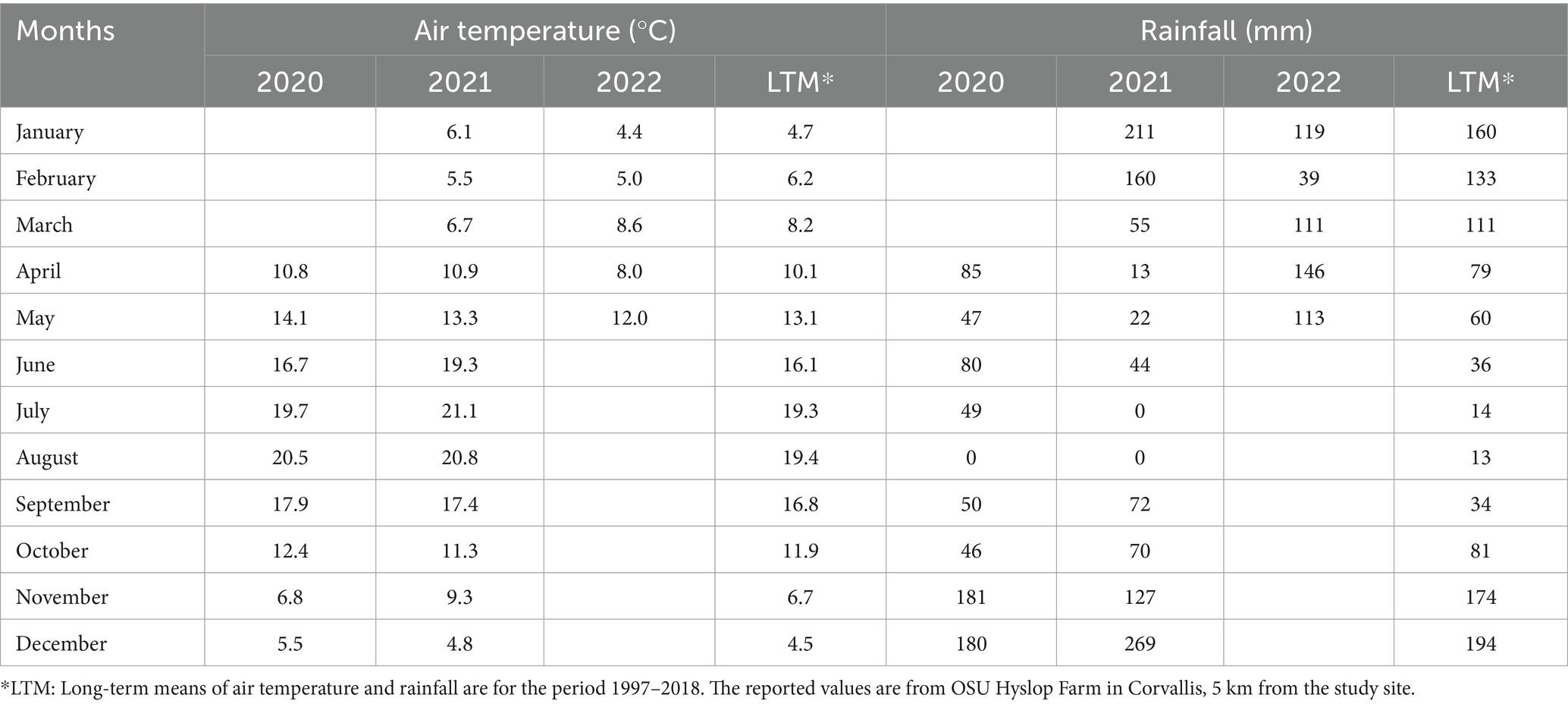- 1Department of Civil and Construction Engineering, Oregon State University, Corvallis, OR, United States
- 2Department of Biological and Ecological Engineering, Oregon State University, Corvallis, OR, United States
- 3Council for Agricultural Research and Economics (CREA), Research Centre for Olive, Fruit and Citrus Crops, Spoleto, Italy
- 4Department of Animal and Rangeland Sciences, Oregon State University, Corvallis, OR, United States
Integrating livestock grazing with photovoltaic (PV) systems offers a promising strategy to enhance both agricultural and energy outputs from the same land. However, limited information is available on how field preparation methods and microclimatic conditions affect pasture establishment and productivity. This study evaluated the effects of three field preparation methods and intra-array shading on pasture germination, establishment, and herbage yield in an agrivoltaic system. Treatments included: (i) tillage followed by plastic cover (TP), (ii) plastic cover only (P), and (iii) herbicide application only (H), all applied prior to sowing. A diverse pasture mixture, comprising perennial ryegrass (Lolium perenne L.), orchardgrass (Dactylis glomerata L.), white clover (Trifolium repens L.), birdsfoot trefoil (Lotus corniculatus L.), chicory (Cichorium intybus L.), and plantain (Plantago lanceolata L.) was sown in between ground-mounted PV panels in spring 2020. Pastures were harvested periodically over two growing seasons from four 1 m-wide zones (A to D) within the alleys between arrays, with shading intensity decreasing from zone A (south side, under the panels) to zone D (north side of the alley). Photosynthetic photon flux density (PPFD) was monitored using calibrated photodiodes. TP resulted in the highest seedling establishment (782 plants/m2, p < 0.01), followed by P (681 plants/m2), and H (457 plants/m2). However, herbage production did not differ significantly among establishment methods in either 2020/21 (p = 0.10) or 2021/22 (p = 0.17). Herbage production was substantially lower in the most shaded zone (A) compared to the other zones (p < 0.01), while zones B, C, and D, despite varying light availability produced similar herbage yields, with zone D underperforming relative to zones B and C despite higher light input. These findings suggest that while field preparation influences seedling establishment, it has limited long-term impact on biomass production. In contrast, heavy shading in zone A substantially restricts productivity, whereas light availability in the remaining zones does not appear to be the primary limiting factor for herbage yield. This insight can inform design and management strategies to maximize agricultural productivity in agrivoltaic systems.
1 Introduction
The expansion of renewable energy infrastructure is essential for addressing climate change and supporting a growing global population. In 2023, the United States installed over 32 gigawatts direct current (GWdc) of solar capacity, a 51% increase from the previous year (Solar Energy Industries Association and Wood Mackenzie, 2024). National capacity is expected to quadruple by 2034 and become the leading source of electricity generation in the United States by 2040. As solar energy development accelerates, concerns have emerged regarding land use, particularly in areas traditionally dedicated to agriculture (Adeh et al., 2019; Swanson et al., 2025; Wei et al., 2025) and ecosystem services (Sturchio and Knapp, 2023; Hernandez et al., 2014). Agrivoltaic systems which combine solar energy production with agricultural activities offer a promising strategy to address this land-use conflict. In addition to producing clean energy, these systems can support farming operations by supplying power for irrigation, processing, and other infrastructure (Santra, 2017; Weselek et al., 2019). Another type of multi-use solar, ecovoltaic systems combine solar energy production with ecological restoration plantings as a way to maximize benefits to soil health, groundwater, and wildlife while meeting energy production goals (Sturchio and Knapp, 2023).
Research has shown that agrivoltaic systems can maintain or even enhance land-use efficiency and overall productivity when appropriately managed (Dupraz et al., 2011; Dinesh and Pearce, 2016). The integration of livestock grazing with solar installations is gaining traction and has demonstrated potential to further increase land productivity (Andrew et al., 2021; Stewart et al., 2025). However, the introduction of photovoltaic (PV) panels alters the local microclimate by partially shading the underlying area. This shading reduces light availability and affects soil temperature and moisture, which in turn can influence pasture germination, growth, and persistence (Adeh et al., 2019; Sturchio et al., 2022). The extent to which these changes impact forage production depends on the physiological requirements of the species sown and their tolerance to variable light and hydrothermal conditions (Devkota et al., 1997; Dodd et al., 2005). Optimizing agrivoltaic systems therefore requires a deeper understanding of how microclimatic factors interact with agronomic management practices.
Successful pasture establishment under solar panels depends on creating favorable agronomic conditions that promote seed germination and seedling development. Effective weed control and appropriate soil preparation are critical, as they minimize competition for resources and enhance seed-to-soil contact, both of which are essential for timely and uniform germination (Thom et al., 2011). Soil preparation methods such as tillage can help break up compaction, improve aeration and water infiltration, and create a fine, even seedbed, conditions that are particularly important when sowing diverse pasture mixtures containing species with different seed sizes and germination requirements (Hampton et al., 1999). However, implementing conventional soil preparation methods in agrivoltaic systems can be challenging. The physical layout of ground-mounted PV arrays often restricts access for agricultural machinery, limiting the feasibility of tillage and other equipment-dependent practices (Stewart et al., 2025). As a result, alternative or low-impact soil preparation strategies are needed to ensure successful pasture establishment in these environments.
In addition to these physical constraints, the altered light and moisture conditions beneath and between solar panels may further influence persistence of pastures, depending on the specific requirements of the pasture species and management factors (Moot et al., 2000; Andrew et al., 2024; Rosati et al 2023). Thus, this study evaluated how different soil preparation methods and shade levels affect pasture establishment and productivity within an agrivoltaic system. A diverse mixture of forage species was sown, and both seedling establishment and total dry matter production were assessed. Three pre-sowing weed suppression treatments were tested: tillage followed by plastic cover (TP), plastic cover alone (P), and herbicide application (H). The alleys between photovoltaic arrays were divided into four equal 1.0-meter zones. Each zone received a different level of incident radiation, enabling an assessment of how shade intensity influences forage establishment and yield.
2 Materials and methods
2.1 Site, establishment and design
The field research was conducted at the Vegetable Farm Solar Array (The Veg Farm), located at the Oregon State University Extension Station in Corvallis, Oregon (54° 16′53.4” N, 122° 45′). The soil is a Chehalis Silt Loam with acidic characteristics (class 1 agricultural soil). The solar array system was established in 2015. The experiment took place between April 2020 and May 2022. Land preparation and planting began in April and May 2020. The land was divided into nine plots and randomly assigned to soil preparation treatments. In October 2020, a soil test (0–20 cm) revealed NO3 = 25 ppm, PO4 = 38 ppm, Ca = 4,269 ppm, Mg = 1,069 ppm, and K = 285 ppm. The site has a Mediterranean climate according to the Köppen-Geiger climate classification system. During summer 2021, the daily air temperatures were often higher than the long-term mean (LTM) (Table 1). Additionally, rainfall in most of March through August 2021 was 45% lower than the LTM. In contrast, rainfall between April and June 2022 was 67% higher than the LTM.
The experiment was a completely randomized plot design with three replicates. Nine pasture establishment plots (6 × 4 m) were randomly assigned to three soil preparation treatments between solar arrays: (i) tillage and plastic cover (TP), (ii) plastic cover only (P) and (iii) herbicide application only (H). On 21 August 2019, all plots were mowed, and broadcast sprayed with glyphosate (1.0 kg ai/ha). TP plots were tilled with a BCS two-wheel tractor with rototiller attachment on 19 August 2019. Following the tillage of TP plots both TP and P plots were covered with 0.15 mm black plastic. Another application of glyphosate (1.0 kg ai/ha) was done in herbicide only plots on 29 April 2020. Plastic was removed on 10 May 2020, and all plots were planted with a diverse pasture seed mix using a self-propelled lawn overseeder (Classen TS-20, Southampton, PA, USA). Plots were rolled with a steel drum lawn roller to improve seed-to-soil contact. The pasture seed mixture consisted of orchardgrass (Dactylis glomerata L.), perennial ryegrass (Lolium perenne L.), white clover (Trifolium repens L.), birdsfoot trefoil (Lotus corniculatus L.), chicory (Cichorium intybus L.) and plantain (Plantago lanceolata L.) All the legumes were inoculated with appropriate Rhizobia strains. The species sown and the seeding rates of each pasture mixture are presented in Table 2.
A slug bait (FERROXX®, containing 5% sodium ferric EDTA as the active ingredient) was applied at a rate of 5 kg ha−1 at the time of seeding. Urea sulfate fertilizer (Ureasul®, Wilco; 33–0–0–12) was applied to all treatments at a rate of 50 kg N ha−1 in May 2020 and May 2021. Plots were maintained under rainfed conditions, with no supplemental irrigation.
2.2 Measurements
2.2.1 Photosynthetic photon flux density
To account for varying shade levels, the 4 m-wide alleys between the solar arrays were divided into four equal zones, each 1.0-m wide. Zone A was the southernmost part of the alley, and began about 30 cm north from the legs of the south panels and ended about 20 cm north of the vertical projection of the hedge of the panels. Zone D was the northernmost part of the alley, and ended at the vertical projection of the PV panel edge on the north side (Figure 1). In 2022, the Photosynthetic Photon Flux Density (PPFD) was measured in each 1.0 m zone, using four PAR (Photosynthetically Active Radiation) sensors (GaAsP photosensors, Hamamatsu, Japan) per zone, placed at about 20, 40, 60 and 80 cm from the edge of each zone. These sensors were calibrated against a quantum sensor (LI-190; LI-COR Inc., Lincoln, NE, USA) and connected to a data logger. PPFD was recorded every minute (minutely values) from dawn to dusk. Minutely values for the four sensors in each zone were averaged, and the average values were then summed up to calculate monthly and yearly values for each zone.
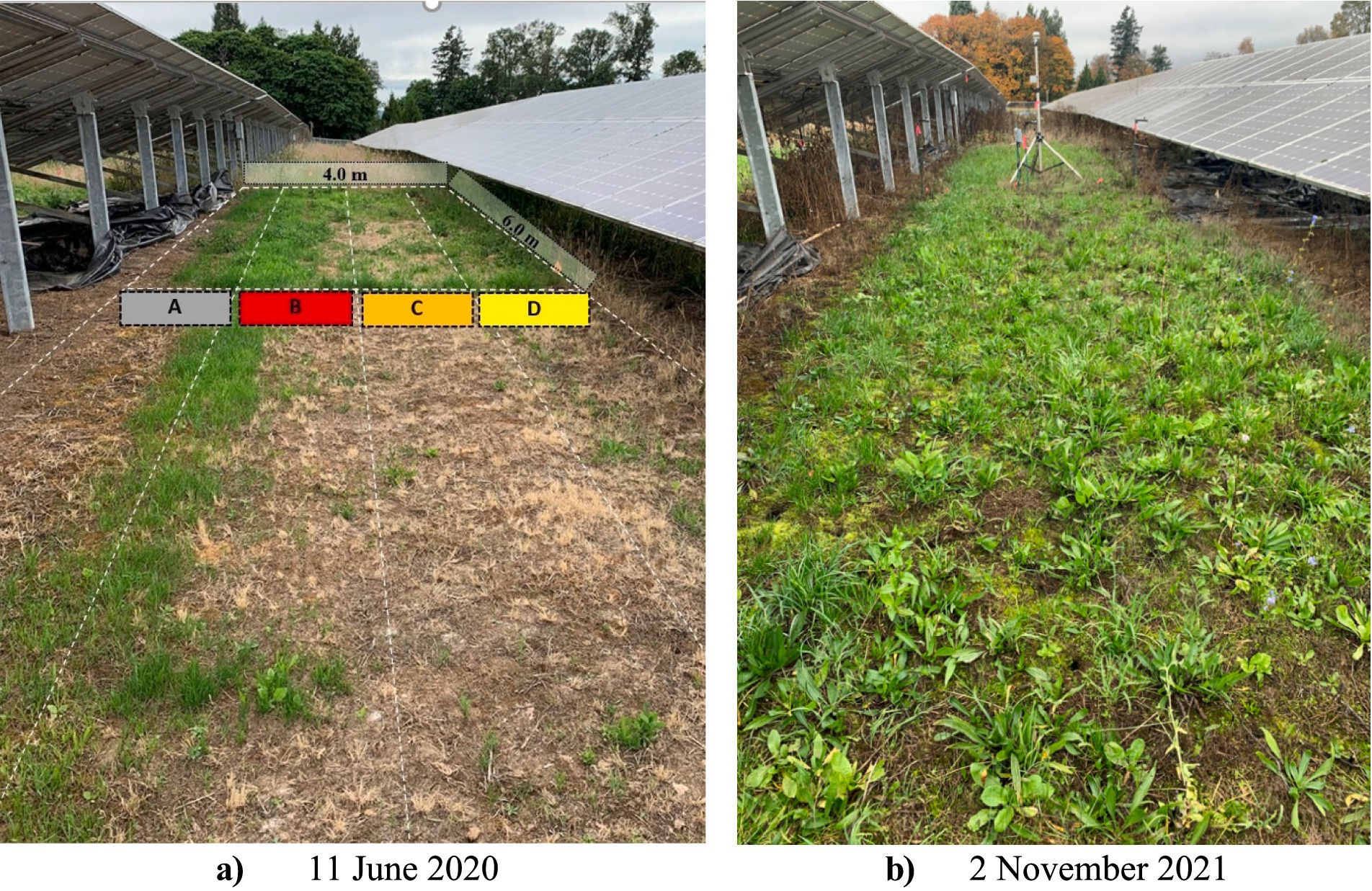
Figure 1. Views of the four 1.0-m-wide shade zones within the solar arrays and the experimental plots during the establishment phase on 11 June 2020 (a), and of the established pastures on November 2, 2021 (b).
2.2.2 Soil moisture and temperature
At the beginning of 2021, soil moisture and temperature sensors (model: 5TM, Decagon Devices, Inc., Pullman, WA, USA) were placed in each treatment. Because of limitations in the number of sensors available, in each soil preparation treatment replication, one sensor was placed in zones A, one between zones B and C, and one in zone D, for a total of nine sensors. Sensors were installed at a depth of 30 cm, and connected to an EM50 logger station (METER Group, Pullman, WA, USA).
2.2.3 Seedling counts, herbage dry matter (DM) production and chemical analysis
Seedling numbers of pasture species in each shade zone were counted in three randomly placed 0.1m2 quadrats after germination on 19 June 2020. Herbage production was determined by cutting a random 0.25 m2 quadrat with electric shears to a stubble height of 50 mm in the four shade zones in each plot on 16 July and 22 October in 2020 and on 21 April, 27 May, 15 July and 28 November 2021, and 30 April 2022. The herbage production in zone A across different establishment methods was marginal. Therefore, no harvest was done in that zone until summer 2021. Mean daily growth rates (kg DM ha−1 day−1) were calculated at each harvest by dividing total DM production (kg DM ha−1) by the duration of regrowth (days) since the previous harvest. The herbage was sorted into botanical fractions (sown species and weeds) and then dried in a forced-air oven at 65°C for 48 h for dry matter (DM) determination. Following collection of the samples, the remainder of the plots was mown to a stubble height of 50 mm. A well-mixed bulk pluck sample was ground in a Wiley mill using a 1 mm screen (Thomas/Wiley, Swedesboro, NJ, USA) for chemical analyses using Association of Official Analytical Chemists methods (AOAC, 2016). Samples were analyzed for DM (method 930.15). Ground samples were analyzed for nitrogen content (N %) by a LECO N analyzer (LECO FP828, MI, USA). Neutral detergent fiber (NDF) and acid detergent fiber (ADF) were assayed sequentially using an Ankom200 Fiber Analyzer (ANKOM Technology Corp., Macedon, NY, USA) (Van Soest et al., 1991). The NDF was analyzed with the inclusion of a heat stable α − amylase and sodium sulfite.
2.3 Statistical analysis
Established seedling numbers, total herbage DM production and botanical composition were analyzed by analysis of variance (ANOVA) with three replicates of a strip plot design where establishment method was the main plot factor (column) and the shade zone was the sub plot factor (rows). The effect of establishment method and shade on pasture growth rates and the nutritive value (ADF, NDF, and CP) by ANOVA with three replicates of a strip plot design where establishment method was the main plot factor (column) and the shade zone was the sub plot factor (rows) at each harvest date. Normality of data was tested using Shapiro Wilk test. Separation of treatment means declared significant by ANOVA were compared by Fisher’s method of protected least significant difference (LSD) at a p = 0.05. The computations were conducted using GENSTAT statistical software.
3 Results
3.1 Soil moisture and temperature
Soil moisture, expressed as volumetric water content (VWC), decreased sharply from March through August 2021, following the reduced rainfall, compared to the long-term average (Figure 2a). This moisture loss was slower in zone A (the most shaded), compared to the other zones. By August 2021 all treatments reached the same minimum soil moisture, and recovered thereafter, until December 2021, after which they remained at similar constant values until the end of the experiment, with no spring drop as in 2021, since rainfall was similar (March) or greater (April and May) that the long-term average. Soil temperature increased in spring and summer and decreased in autumn and winter but, in Spring 2021, it increased less in the most shaded zone A, where moisture was higher, than in the other zones (Figure 2b).
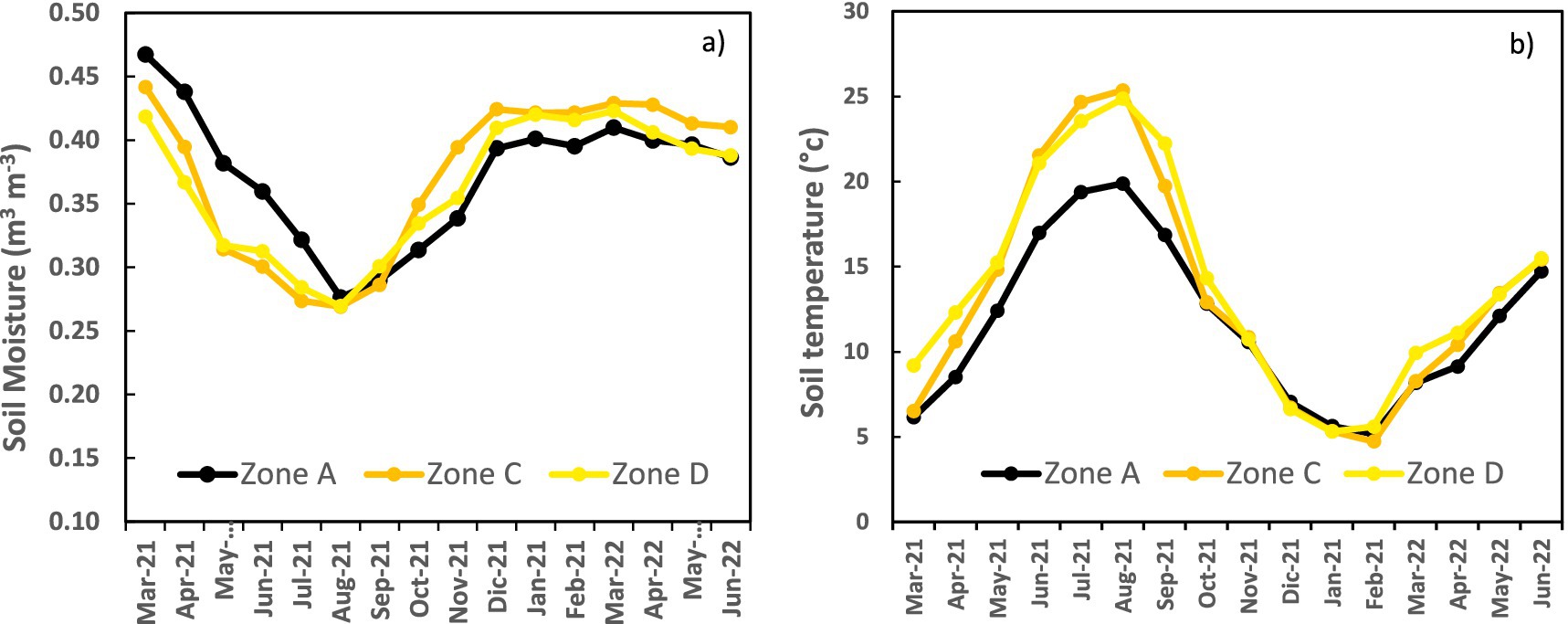
Figure 2. Monthly averages of (a) soil moisture (volumetric water content, m3 m−3) and (b) soil temperature, in zone A (the most shaded), zone B/C (sensor placed between the two zones) and zone D (the most sunlit).
3.2 Incoming radiation in the different zones
The radiation (i.e., photosynthetic photon flux density, PPFD) incident on the different zones was lowest in the October–February period, and peaked in June (zone A) or July (all other zones) (Figure 3a). Over the whole year, the PPFD reaching the ground varied from about 1,550 mol m−2 in zone A, to about 7,200 mol m−2 in zone D. However, the variation in irradiance was not uniform during the year, with greater reductions in irradiance, compared to zone D (the most illuminated zone overall) in Spring (March) and Autumn (October) (Supplementary Figure S1). Over the whole year, the reduction in incident irradiance, compared to zone D, was minor for zone C (9%) and medium for zone B (45%), while the reduction was dramatic (78%) for zone A (Figure 3b).
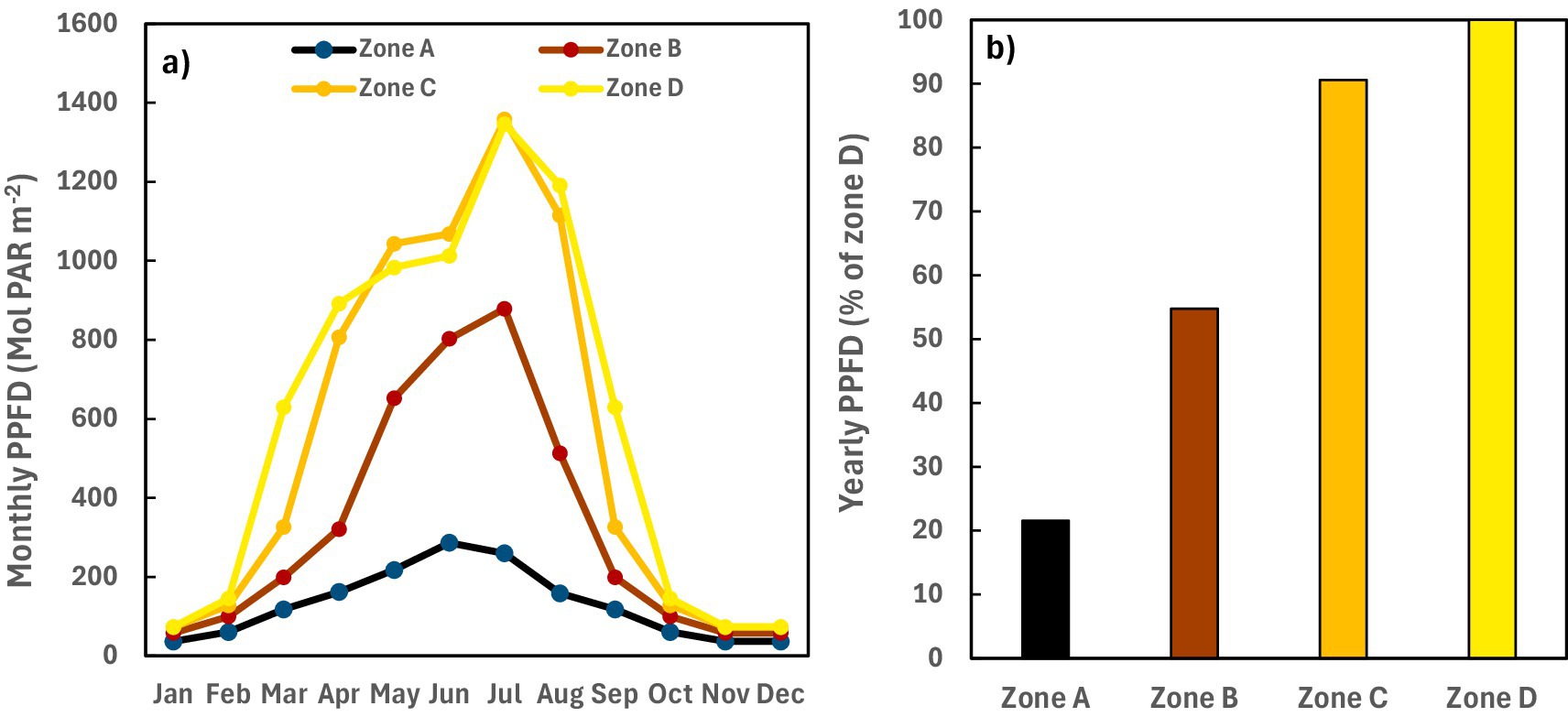
Figure 3. (a) Monthly pattern (expressed in absolute terms) and (b) yearly totals (expressed in percentage of the zone D, the most sunlit zone overall), of incident radiation (Photosynthetic Photon Flux Density, PPFD), in the different zones of the alley between PV panel arrays.
3.3 Established seedling number
Significant effects of soil preparation (p < 0.01) and shade zones (p < 0.01) were recorded on established seedling numbers (Figure 4). The highest number of seedlings was recorded in tillage and plastic treatment (782 plants/m2), followed by plastic only (681 plants/m2). The herbicide only treatment provided the lowest established seedling numbers (457 plants m−2). The highest number of established seedlings was recorded in zone B (981 plants m−2) while the lowest number occurred in the most shaded zone A (406 plants m−2), and the number of seedlings was intermediate in zone C and D (578 and 590 plants m−2, respectively). In regards to individual plant species, establishment method and shade had a major effect (all p < 0.05) on the number of established seedlings for all species except birdsfoot trefoil and orchardgrass. The number of birdsfoot trefoil seedlings was similar with till and plastic and plastic only methods but greater (p < 0.05) than herbicide only establishment method. However, birdsfoot trefoil was the only species whose seedling numbers were not affected (p = 0.19) by shade regimes. In contrast, establishment method did not affect the number of orchardgrass seedlings (p = 0.16). The number of seedlings was dramatically higher in zone B than other shade zones for all the pasture species including broadleaved weeds. Plantain, white clover and broadleaved seedling numbers were substantially lower (p < 0.05) in the most shaded zone A than other zones.
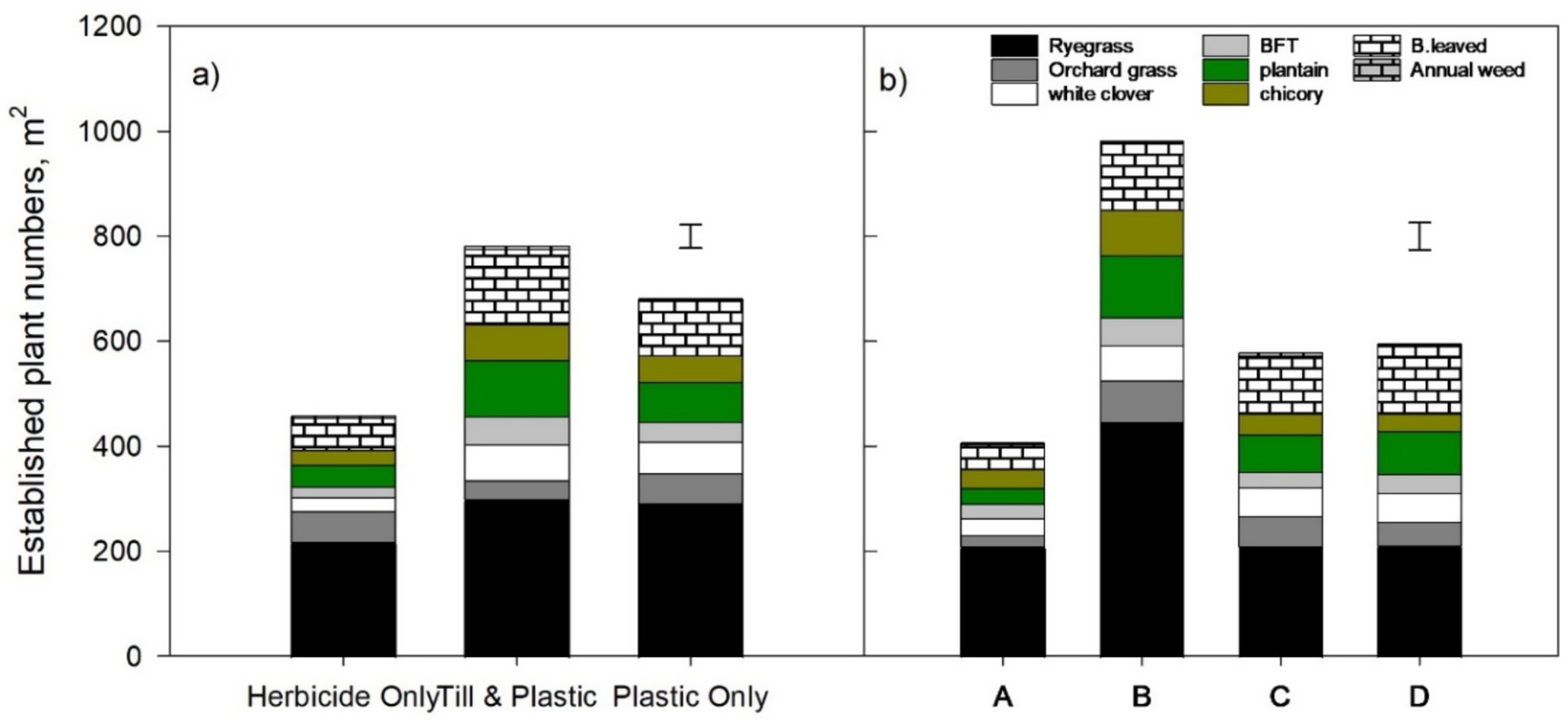
Figure 4. Established seedling numbers on 19 June 2020, as affected by (a) soil preparation method and (b) shade zones in the agrivoltaic system. Bars represent SEM for total number of plants.
3.4 Herbage dry matter (DM)
The herbage dry matter (DM) production from the different sampling dates is shown as cumulated production over the first year (including all harvests up to 23 April, 2021), and the second year (including all subsequent harvests, ending with 1 May 2022). In the first year (2020/21), DMP did not differ (p = 0.10) among pasture establishment treatments (Figure 5a). However, zone A had a much lower (p < 0.01) DMP than other shade zones. Similarly, in the second year (2021/22), the method of establishment had no effect on pasture DMP (p = 0.17) but zone A had the lowest (p < 0.01) DMP, while zone B and C had the highest DMP, and zone D had intermediate DMP (Figure 5b).
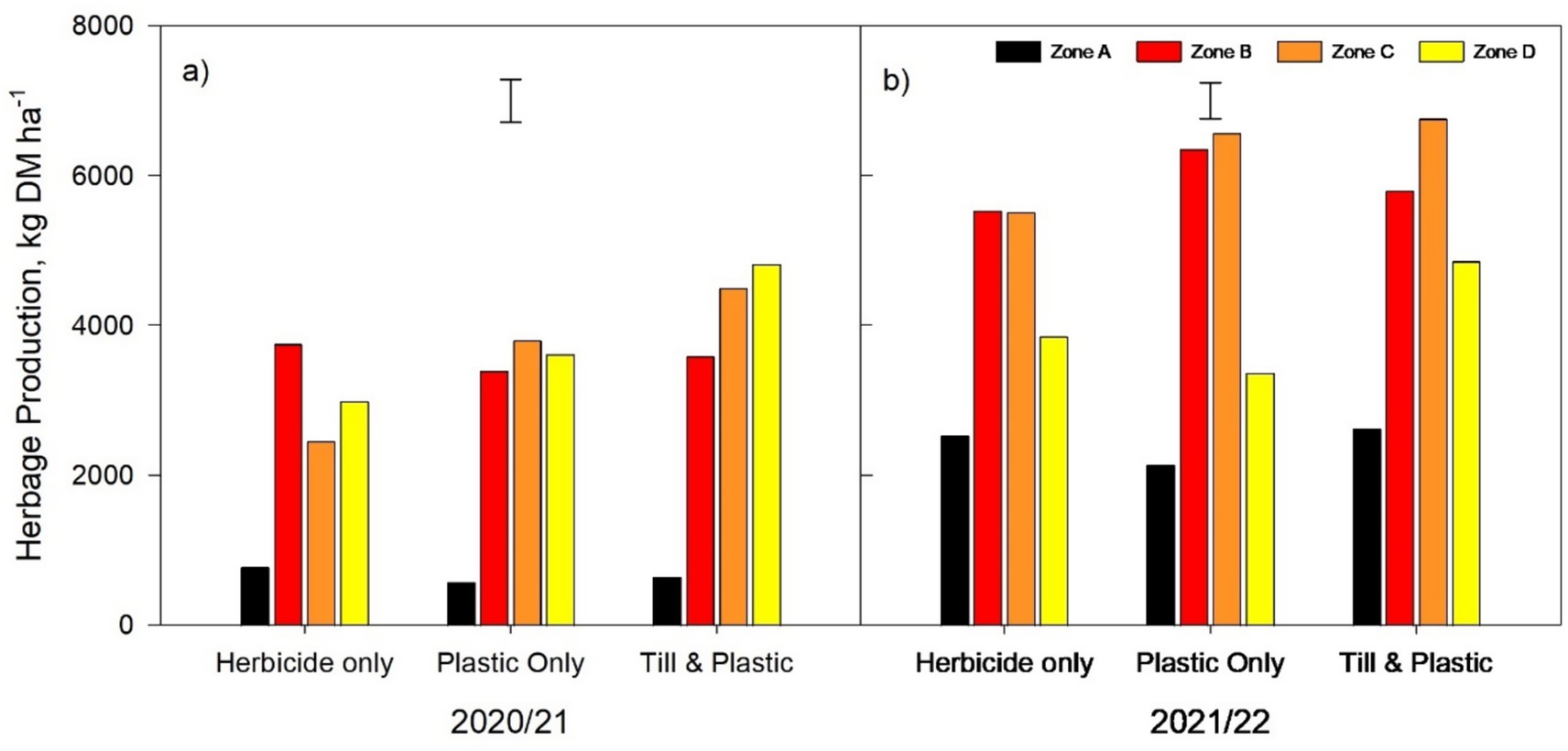
Figure 5. Herbage dry matter (DM) production of pastures as affected by soil preparation method and shade zones in agrivoltaic systems in the first (2020/21) (a), and second (2021/22) (b) year after establishment. Bars represent SEM for establishment method and shade zone interaction.
3.5 Botanical composition
Both establishment method and shade had an impact on the establishment and composition of pasture species (Figures 6a–d). In the first year (2020/2021) after establishment (Figures 6a,b), perennial ryegrass content of pastures did not differ based on the establishment method (p = 0.84), but shade zone D (most sunlit) tended (p = 0.08) to have lower ryegrass content than zone B (7.5 vs. 17.5%). In contrast, shade zones did not affect orchardgrass content, but orchardgrass content was higher with herbicide only method than with the other two establishment methods. Similarly shade zone did not affect chicory proportion of the pastures, while pastures tended to have lower (p = 0.05) plantain in zone A than other zones. Conversely, plantain content did not differ (p = 0.52) among establishment methods, while pastures appeared to have higher (p = 0.06) chicory when established with plastic only method than other establishment methods. White clover content ranged from 1.6–6.0% and was affected both by establishment method (p < 0.01) and shade zone (p < 0.01). White clover content was higher in zone A than other zones and when the soil was prepared using till and plastic than other methods. Birdsfoot trefoil content was marginal (0.2–2.4%) but was higher (p < 0.05) in zone D than other zones. However, its content in pastures did not differ (p = 0.38) among pasture establishment methods. The weed content did not differ based on the establishment method, but it was higher (p < 0.05) in zone A than other zones. Pastures in zone B had higher (p < 0.01) dead material than other zones, while pastures in zone A did not generate any dead material.
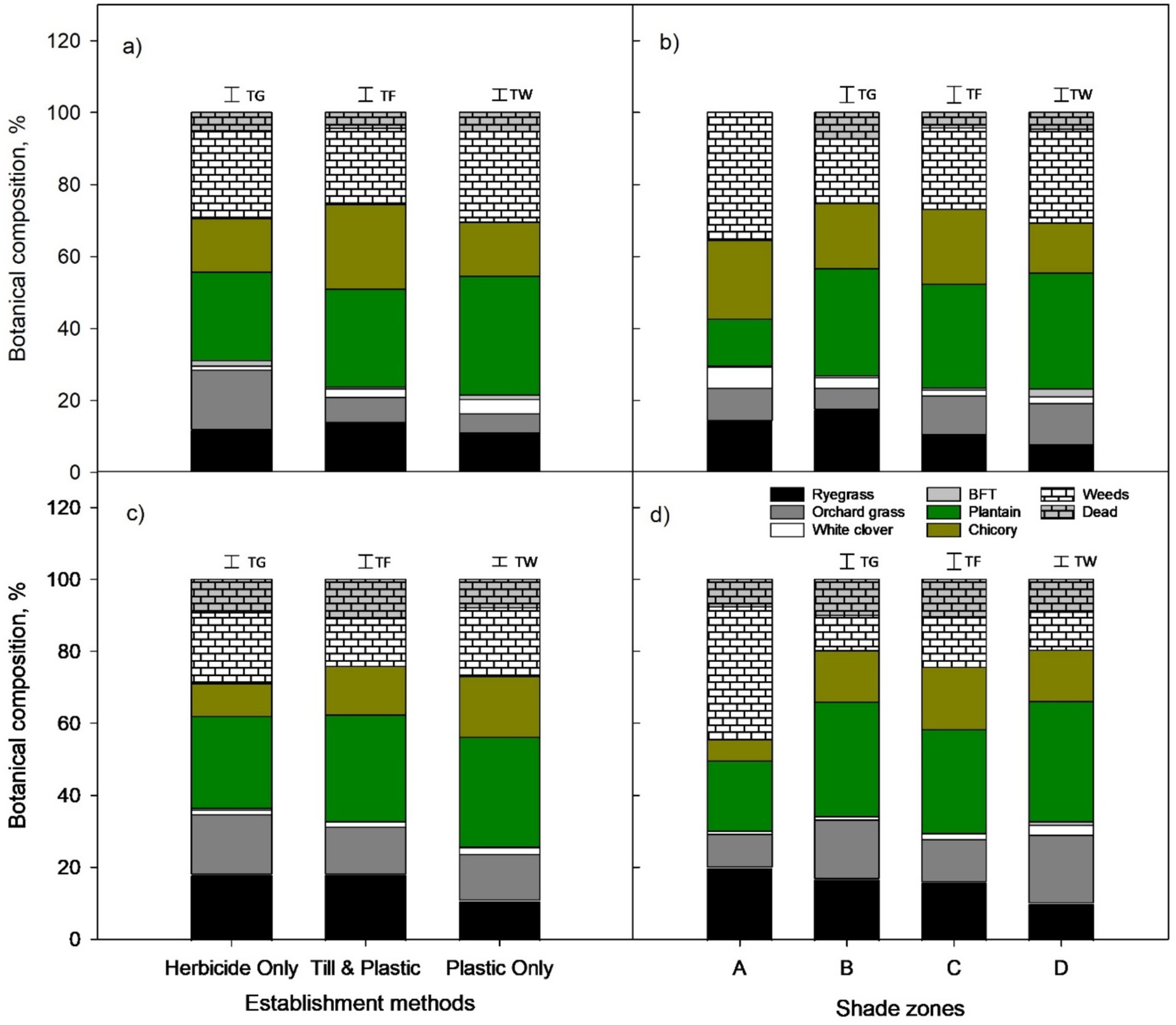
Figure 6. Botanical composition (%) of pastures as affected by establishment method (a,c) and shade zones (b,d) in agrivoltaic systems in first (2020/21) (a,b), and second (2021/22) year after establishment (c,d). Bars represent SEM for total grasses (TG), total forbs (TF) and total weeds (TW). BFT = Birdsfoot trefoil.
In the second year (2021/2022) after establishment (Figures 6c,d), establishment method affected only chicory and orchardgrass. The content of chicory and orchardgrass was higher (p < 0.05) in plastic only and herbicide only method respectively, than other methods. The effect of shade on perennial ryegrass, plantain, birdsfoot trefoil, weeds and dead material content were consistent with the previous growing season (all p < 0.05).
3.6 Mean daily growth rates
Mean daily growth rates of pastures differed based on pasture establishment methods in July 2020 and May 2022 (p < 0.05), while the difference among shade zones were significant at all harvests (all p < 0.05; Figure 7). The highest pasture growth rates were recorded in early June 2021, for all establishment methods and shade zones. Mean daily pasture growth rates in pastures that were established using till and plastic were higher than plastic only establishment method in July 2021 and both herbicide only and plastic only establishment methods in May 2022. However, despite being significant, such differences were minimal, and much smaller than differences across sampling dates and shade zones. Mean daily pasture growth rates were consistently the highest in zones B and C, while zone A had the lowest growth rates throughout the experimental period (all p = 0.05). No interactions were detected between pasture establishment and shade zones for mean daily growth rates (all p > 0.05).
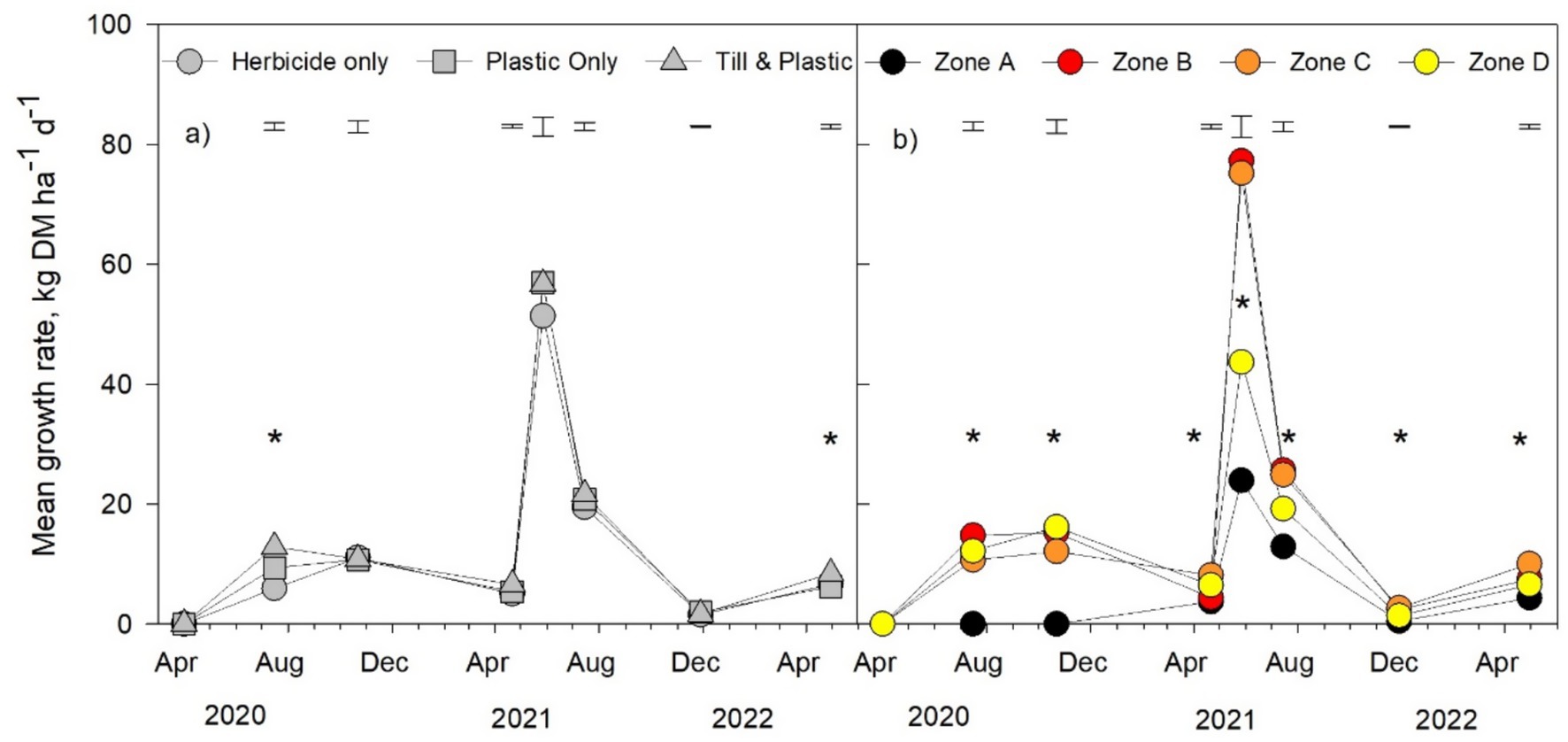
Figure 7. Mean daily growth rates of pastures as affected by soil preparation method (a) and shade zones (b) in agrivoltaic systems, at the different sampling dates during the experiment. Bars represent SEM. *Above the period indicates that the difference was significant at that sampling time (p < 0.05).
3.7 Nutritive value
The establishment method affected ADF content of pastures only on 16 July 2020 when forages had higher (p < 0.05) ADF content in herbicide only than other establishment methods (Figure 8a). The ADF and NDF content of pastures were higher (p < 0.01) in zone A than zones C and D in harvests on 21 April 2021 and 30 April 2022 (Figures 8a–d). An interaction was detected (p < 0.05) between establishment methods and shade zones for NDF content on 22 July 2021 as pastures established with herbicide only method had higher NDF in zone C than those established with till and plastic method, while the NDF content in other zones did not differ. In contrast, pastures had higher CP in zones A and B than C and D on 21 April 2021 (Figures 8e,f). While this effect disappeared for ADF and NDF in the subsequent harvests, it was persistent with CP, in all harvests except on 22 October 2020 and on 22 July 2021 when the CP content of pastures was similar across pasture establishment methods and shade zones (all p > 0.05). Pasture establishment method did not affect (all p > 0.05) CP content of pastures over the 2-year experimental period. It was of note that the CP content of pastures in zones A, B was only higher (p < 0.05) than zone D but similar to zone C on 28 November 2021.
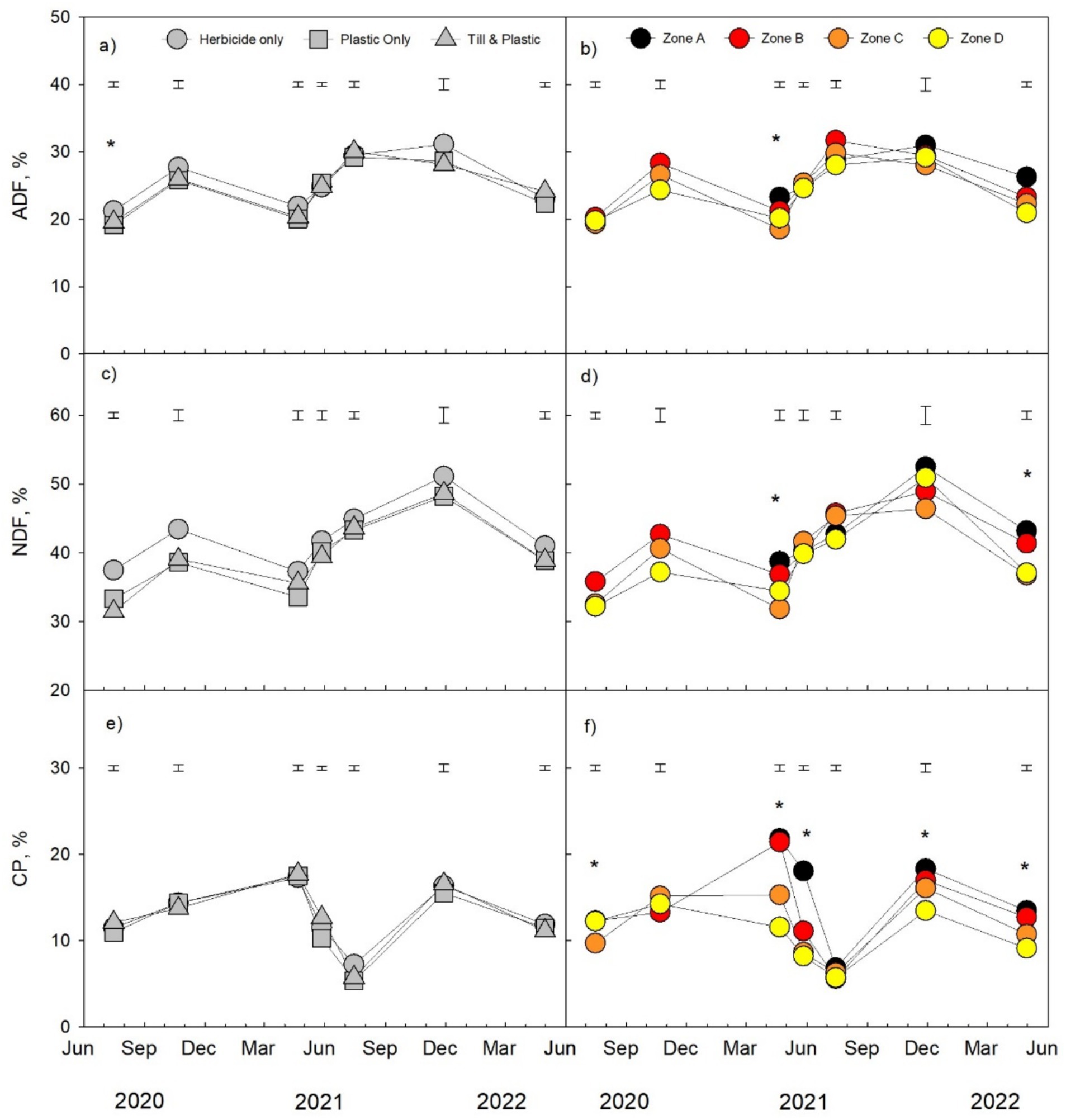
Figure 8. Nutritive value (%) of pastures as affected by soil preparation method (a,c,e,g) and shade zones (b,d,f,h) in agrivoltaics systems, at the different sampling dates during the experiment. Bars represent SEM. *Above the period indicates that the difference was significant (p < 0.05).
4 Discussion
The present study provides an insight into the complex relationship between soil preparation methods, shading, and their interaction on several variables such as soil moisture and temperature, seedling establishment, herbage dry matter production (DM), botanical composition, growth rates, and the nutritive value of pastures grown in an agrivoltaics system. Our research illustrates that both the level of shading and the soil preparation approach play a role in seedling establishment. Till and plastic soil preparation led to higher number of established seedlings but the pasture DM production was not affected by soil preparation method. The shade zone had more dramatic effect on pasture yield, botanical composition and nutritive value. Heavy shade (zone A) caused a reduction in forage yield and growth rates but an increase in crude protein content of forages. This is in line with the findings of Weselek et al. (2021) and Andrew et al. (2024) who reported similar reduction in forage production in partially shaded areas under ground-mounted, fixed axis solar panels. In contrast, Sturchio and Knapp (2025) reported an approximately 20% increase in herbage production within solar arrays compared to adjacent open grassland, with some locations, particularly near panel edges in single-axis tracking systems showing yield increases of up to 90%. Together, these contrasting outcomes highlight the importance of system design and spatial variability within arrays. As suggested by Dupraz et al. (2011) and Marrou et al. (2013), well-designed agrivoltaic systems can be optimized to not only minimize yield losses but potentially enhance pasture productivity, particularly when microclimate conditions are managed to benefit plant growth.
In the current study, soil preparation using till and plastic method possibly created the good seedbed and favorable conditions for germination and seedling growth, leading up to an average of 782 established plants/m2. Plastic cover is not a conventional approach for weed control in pasture systems, and there is limited research on its impact on pasture establishment. It is likely that the plastic cover facilitated water retention in the topsoil (0–5 cm) (Díaz-Hernández and Salmerón, 2012), creating a favorable environment for seedling germination. Although the established seedling numbers were much lower in herbicide only treatment, it is of note that the established seeding numbers were still over 400 plants/m2 which is considered to be an agronomically successful establishment (Thom et al., 2011). This was also reflected in the herbage dry matter yields which did not differ in relation to soil preparation methods even during the establishment year when higher plant numbers usually lead to greater yield. However, pastures established with till and plastic resulted in faster growth rates (13 kg DM ha−1 d−1) in early establishment stage (16 July in 2020) than those that were established using plastic only (9 kg DM ha−1 d−1) and herbicide only (6 kg DM ha−1 d−1). This result is in line with the previous research by Ates et al. (2013) who reported a positive correlation between plant density and forage yield during the establishment stage, although the significance of plant density tends to diminish as the season progresses due to compensatory growth of individual plants. In fact, such differences disappeared later on.
Overall, the pasture yield obtained in this current study was similar to the yield of diverse pastures (4.5 t DM ha−1 y−1) that was reported by Andrew et al. (2024) in another agrivoltaics study managed under grazing conditions in Oregon. It is noteworthy that agrivoltaic pasture yields are often lower than those of pastures grown in open fields, as noted by Andrew et al. (2021) and Weselek et al. (2021). However, in arid conditions where water and not light is the limiting factor, the reduction in light availability can decrease crop evapotranspiration and water stress and increase yield (Sturchio et al., 2022; Sturchio et al., 2025), although this was not the case under the conditions of this study. The pasture establishment methods had variable effects on the production and persistence of individual plant species. It is probable that relative competitiveness of each species was altered by the soil preparation and their tolerance to shade (Shelton et al., 1987). At the establishment stage in 2020, the proportion of orchardgrass was much higher with herbicide only (16.4%) than other two soil preparation methods (5.4–6.9%). It is likely that the fast-establishing plant species such as perennial ryegrass, plantain and chicory benefitted the conducive environment created by herbicide only and plastic and till preparation methods suppressing the slow-establishing orchardgrass. It is of note that the total proportion of perennial ryegrass, plantain and chicory was 51.4%, 64.7 and 58.9% in herbicide only, plastic only and till and plastic establishment methods, respectively. Over the entire experimental period, pastures were composed predominantly of sown grasses, non-leguminous forbs and broadleaved weeds, while the proportion of legumes remained less than 3% in the pastures. The poor legume persistence in agrivoltaics was also highlighted by Andrew et al. (2024) due to their low tolerance to shade as reported by (Pang et al., 2019). In contrast, both plantain and chicory contributed to the forage production substantially covering over 40% of the botanical composition. This outcome validates the conclusions drawn by Devkota et al. (1997), who categorized plantain as a forb with moderate shade tolerance. Our findings align with those of Andrew et al. (2024), who suggested the inclusion of forbs in agrivoltaic pastures as a means of diversification. The low proportion of birdsfoot trefoil confirms the observations of Devkota et al. (1997), who identified Lotus species as the most shade-tolerant legumes albeit with lower shoot yield than white clover and subterranean clover (Trifolium subterraneum) as it takes longer to establish than most other legumes. Thus, the low proportion of birdsfoot trefoil could be due to the poor competitiveness of birdsfoot trefoil, a typically slow establishing legume (Seeno et al., 2022). The pastures in the current study contained about 20% weeds independent of the establishment method, while weeds were in much greater proportion in the most shaded zone A (almost 40%) than in the other zones (10–15%). This large proportion of weeds potentially contributed to reduced pasture yield in zone A, although the 78% reduction in incident radiation was probably the main factor. Our finding of increased weeds with increasing shade is in line with Dodd et al. (2005) who demonstrated a close positive relationship between weed content and shade intensity. Overall, weed management is a major issue in agrivoltaics pastures and robust weed management practices are needed for pasture establishment in agrivoltaics (Andrew et al., 2024). Yet, weeds are usually mostly palatable for grazing livestock, and therefore they can be tolerated better in a pasture, where they are part of the yield than in other crops, where they would detract from the yield by competing with the crop. This makes grazing and forage production an easier option for agrivoltaics systems, than crop cultivation where weed management would have to be more effective, which is difficult to achieve under and around PV panels.
The results of this study showed that there was a consistent pattern of lower dry matter production in the most shaded part of the alley (zone A) as compared to the other zones. Previous studies carried out either under artificial shade conditions (Varella-Garcia et al., 2001; Dodd et al., 2005) or within silvopastoral systems (Devkota and Jha, 2009) indicated that light plays a predominant role in determining understory forage production. It is noteworthy that the decline in pasture growth rates and overall annual forage production in the most shaded area (zone A) was accompanied by a delayed decline in soil moisture levels in these areas during the late-spring and early-summer months. Thus, light and not soil moisture appears to have limited forage production in the most shaded zone A. This contrasts with the findings of Adeh et al. (2019), who reported a 90% increase in forage yield under full shade during summer. Although more modest, Andrew et al. (2021) and Andrew et al. (2024) also noted a slight rise in forage yield in fully shaded areas during summer, though this increase did not offset the decreased growth in spring and fall.
In the present study, the consistently lower forage yield in the most shaded zone A might also result in part from poor forage establishment, coupled with a higher proportion of weeds in these areas. Dry matter production was significantly higher, at all sampling dates, in the other three zones, which received greater irradiance. However, zone B had similar biomass production as zones C and D, despite receiving little more than half the radiation, suggesting that light was not limiting biomass production, except for zone A. This is further supported by observing that that peak growth rates and peak irradiance did not coincide. Peak irradiance occurred in August (due to a combination of long days and clear sky), while peak growth occurred from late April to Early June 2021. Thus, irradiance was not the limiting factor for biomass production, at least during the summer. Surprisingly, in the second year after establishment, where DM production was highest, zone D produced significantly less than zone B and C, despite receiving the most radiation overall. Thus, something other than radiation appears to have limited DM production in zone D. The relationship between irradiance and DM production is even more complex considering that, although on a yearly basis there was a clear gradient, with decreasing irradiance from zone D to A, this was not always the case when considering the monthly trends. In fact, only in early spring (March) and early autumn (September) the monthly data shows a clear gradient of decreasing irradiance from zone D to A. On all other months, the incident radiation was similar for zones D and C. Zone D, despite having the highest overall irradiance, actually received slightly less irradiance than zone C in May and June, but much higher irradiance in March and September. This should have resulted in greater biomass production in zone D, given that slightly less radiation in the summer should favor, or at least not limit, plant growth in a water-limited and high-temperature-limited, and non-light-limited system (Adeh et al., 2019; Andrew et al., 2021). While greater irradiance in spring, when light is lower and more likely limiting than water, should also promote higher yields. Instead, biomass production in zone D was reduced between one third and one half, in the second growing season (the season with the highest growth), compared to zones B and C. This further supports that something other than radiation limited DM production in zone D. Our preliminary observations suggest that this reduction in biomass production might have been related to water logging and nutrient leaching caused by the PV panels concentrating rainwater in zone D, where we noticed some yellowing of the vegetation after long rainy periods. This hypothesis will be investigated in further studies.
It may be concluded that, in the condition of the present experiment light limited biomass production mostly in Zone A (under the panels), while light was not limiting in the center of the alley (zones B and C), where other factors, likely low temperature in winter and high temperature and/or soil water limitation in the summer, appear to limit plant growth. As for zone D, additional limitations might be related to water logging and nutrient leaching due to rainfall concentration in this area. Thus, shade appeared to be not the main factor limiting forage growth in the agrivoltaics system studied, except under the panels (zone A). The present findings suggest that proper management, with irrigation, cold-hardy and/or drought tolerant crops, and appropriate drainage and nutrient management, might go a long way in improving pasture productivity in agrivoltaics systems, at least in the alley area and in the conditions of the present experiment.
The nutritive value of pastures was also affected by the differences in shade conditions, while soil preparation method virtually had no effects. Notably there was an increase in CP content of pastures in shaded areas. In previous studies, an increase in herbage nitrogen concentration ranging from 0.2% (Dodd et al., 2005) to 0.6% (Ciavarella et al., 2000) was documented in shaded pastures compared to unshaded ones. Increased protein in the shade is documented also in grains (Panozzo et al., 2019) and forages (Mantino et al., 2021). This could be related to the lower lighting causing stimulation of nitrogen accumulation in the growing plants (Elgersma and Søegaard, 2016). This accumulation can be explained by the so-called dilution effect: greater nutrient availability per unit of biomass production (Li et al., 2010; Artru et al., 2017; Arenas-Corraliza et al., 2018). An alternative hypothesis is an extended crop growth period in the shade, such as an extended grain filling period in cereals (Lnurreta-Aguirre et al., 2018; Temani et al., 2021). In contrast, the NDF and ADF contents of forages in shaded areas occasionally were greater in fully shaded areas. This could be related to the fact that, where light is limited, plants tend to elongate, prioritizing resource allocation towards more fibrous structures that provide mechanical support and stability, such as stems (Lin et al., 2001). However, the different species composition in the most shaded zone A, with greater proportion of weeds, might also contribute to explaining the differences in plant composition.
5 Conclusion
The study investigated the impact of different soil preparation methods in an agrivoltaic systems, revealing insights into their complex interactions with shading and microclimatic conditions. Tillage combined with plastic cover resulted in superior seedling establishment, while shading had a more pronounced effect on pasture yield, botanical composition, and nutritive value. Shade had a significant impact, altering the proportion of plant species and favoring the growth of certain fast-establishing species like perennial ryegrass, plantain, and chicory while suppressing slower-establishing species like orchardgrass. Conversely, soil preparation methods, particularly tillage combined with plastic cover, facilitated superior seedbed conditions, enhancing seedling establishment across all treatments. However, except for the early effects on plant establishment, soil preparation methods did not affect sward productivity very much. The effects of shade were more pronounced, but mostly limited to the most shaded zone A (i.e., under the panels, 78% shade). In the alley, shade was intense only in zone B (45% shade), with little differences between zones C and D, and biomass production appeared to be limited more by factors other than light, likely including drought and/or temperature (both high and low) stress. Finally, excessive rainwater collection on the south side of the PV panel arrays might add additional stress in terms of water logging and nutrient leaching, further limiting biomass production, at least in the conditions of this experiment. However, in more arid environment, it is possible that the water collection may enhance yield, rather than reduce it, by alleviating water stress. While the radiation limitation (i.e., shade) due to the solar panels cannot be easily overcome, at least without reducing the electrical output of the agrivoltaic system, it is interesting to know that, at least under the condition of this experiment, biomass production might be limited more often, and on most of the area, by factors other than shade. Therefore, it appears possible to optimize the agricultural management, thus improving the productivity of agrivoltaic systems. However, the results here obtained are closely related to the specific design and geographical location of this experiment, and results might change, at least in some aspects, at different sites with different latitude, climate, soil, and photovoltaic design, particularly panels height, tilt, width, and alley width.
Data availability statement
The original contributions presented in the study are included in the article/Supplementary material, further inquiries can be directed to the corresponding author.
Author contributions
AD: Conceptualization, Investigation, Project administration, Writing – original draft, Visualization, Data curation, Formal analysis. CH: Resources, Conceptualization, Project administration, Methodology, Writing – review & editing, Supervision, Funding acquisition. AR: Writing – review & editing, Investigation, Visualization, Validation, Formal analysis. MG: Project administration, Methodology, Writing – review & editing, Investigation, Conceptualization. SA: Methodology, Validation, Investigation, Visualization, Supervision, Formal analysis, Writing – review & editing, Project administration.
Funding
The author(s) declare that financial support was received for the research and/or publication of this article. This study was supported by the Agricultural Research Fund at Oregon State University.
Acknowledgments
The authors express their appreciation to Alyssa Andrew for providing assistance in fieldwork.
Conflict of interest
The authors declare that the research was conducted in the absence of any commercial or financial relationships that could be construed as a potential conflict of interest.
The author(s) declared that they were an editorial board member of Frontiers, at the time of submission. This had no impact on the peer review process and the final decision.
Generative AI statement
The authors declare that no Gen AI was used in the creation of this manuscript.
Any alternative text (alt text) provided alongside figures in this article has been generated by Frontiers with the support of artificial intelligence and reasonable efforts have been made to ensure accuracy, including review by the authors wherever possible. If you identify any issues, please contact us.
Publisher’s note
All claims expressed in this article are solely those of the authors and do not necessarily represent those of their affiliated organizations, or those of the publisher, the editors and the reviewers. Any product that may be evaluated in this article, or claim that may be made by its manufacturer, is not guaranteed or endorsed by the publisher.
Supplementary material
The Supplementary material for this article can be found online at: https://www.frontiersin.org/articles/10.3389/fsufs.2025.1637340/full#supplementary-material
References
Adeh, E. H., Good, S. P., Calaf, M., and Higgins, C. W. (2019). Solar PV power potential is greatest over croplands. Sci. Rep. 9:11442. doi: 10.1038/s41598-019-47803-3
Andrew, A. C., Higgins, C. W., Smallman, M. A., Graham, M., and Ates, S. (2021). Herbage yield, lamb growth and foraging behavior in agrivoltaic production system. Front. Sustain. Food Syst. 5:659172. doi: 10.3389/fsufs.2021.659175
Andrew, A. C., Higgins, C. W., Smallman, M. A., Prado-Tarango, D. E., Rosati, A., Ghajar, S., et al. (2024). Herbage and sheep production from simple, diverse, and legume pastures established in an agrivoltaic production system. Grass Forage Sci. 79, 294–307. doi: 10.1111/gfs.12653
AOAC. Official Methods of Analysis of AOAC International, 20th ed.; AOAC International : Gaithersburg, MD, USA, (2016).
Arenas-Corraliza, M. G., L6pez-Dfaz, M. L., and Moreno, G. (2018). Winter cereal production in a Mediterranean silvoarable walnut system in the face of climate change. Agric. Ecosyst. Environ. 264, 111–118. doi: 10.1016/j.agee.2018.05.024
Artru, S., Garré, S., Dupraz, C., Hiel, M. P., Blitz-Frayret, C., and Lassois, L. (2017). Impact of spatio-temporal shade dynamics on wheat growth and yield, perspectives for temperate agroforestry. Eur. J. Agron. 82, 60–70. doi: 10.1016/j.eja.2016.10.004
Ates, S., Isik, S., Keles, G., Aktas, A. H., Louhaichi, M., and Nangia, V. (2013). Evaluation of deficit irrigation for efficient sheep production from permanent sown pastures in a dry continental climate. Agric. Water Manag. 119, 135–143. doi: 10.1016/j.agwat.2012.12.017
Ciavarella, M., Demelio, G., Barber, J. R., and Jang, Y. H. (2000). Linear elastic contact of the Weierstrass profile. Proc. R. Soc. Lond. Ser. A Math. Phys. Eng. Sci. 456, 387–405. doi: 10.1098/rspa.2000.0522
Devkota, A., and Jha, P. K. (2009). Variation in growth of Centella asiatica along different soil composition. Botany Res. Int. 2, 55–60.
Devkota, N. R., Kemp, P. D., and Hodgson, J. (1997) Screening pasture species for shade tolerance. In Proceedings of Agronomy Society of New Zealand 119–128.
Díaz-Hernández, J. L., and Salmerón, T. (2012). Effects of a plastic cover on soil moisture change in a M editerranean climatic regime. Soil Use Manag. 28, 596–605. doi: 10.1111/sum.12000
Dinesh, H., and Pearce, J. M. (2016). The potential of agrivoltaic systems. Renew. Sust. Energ. Rev. 54, 299–308. doi: 10.1016/j.rser.2015.10.024
Dodd, A. N., Salathia, N., Hall, A., Kévei, E., Tóth, R., Nagy, F., et al. (2005). Plant circadian clocks increase photosynthesis, growth, survival, and competitive advantage. Science 309, 630–633. doi: 10.1126/science.1115581
Dupraz, C., Marrou, H., Talbot, G., Dufour, L., Nogier, A., and Ferard, Y. (2011). Combining solar photovoltaic panels and food crops for optimising land use: towards new agrivoltaic schemes. Renew. Energy 36, 2725–2732. doi: 10.1016/j.renene.2011.03.005
Elgersma, A., and Søegaard, K. (2016). Effects of species diversity on seasonal variation in herbage yield and nutritive value of seven binary grass-legume mixtures and pure grass under cutting. Eur. J. Agron. 78, 73–83. doi: 10.1016/j.eja.2016.04.011
Hampton, J. G., Kemp, P. D., and White, J. G. H. (1999). “Pasture establishment” in New Zealand pasture and crop science. eds. J. White and J. Hodgson (Melbourne: Oxford University Press), 101–115.
Hernandez, R. R., Easter, S. B., Murphy-Mariscal, M. L., Maestre, F. T., Tavassoli, M., Allen, E. B., et al. (2014). Environmental impacts of utility-scale solar energy. Renew. Sust. Energ. Rev. 29, 766–779. doi: 10.1016/j.rser.2013.08.041
Li, H., Jiang, D., Wollenweber, B., Dai, T., and Cao, W. (2010). Effects of shading on morphology, physiology and grain yield of winter wheat. Eur. J. Agron. 33, 267–275. doi: 10.1016/j.eja.2010.07.002
Lin, C. H., McGraw, M. L., George, M. F., and Garrett, H. E. (2001). Nutritive quality and morphological development under partial shade of some forage species with agroforestry potential. Agrofor. Syst. 53, 269–281. doi: 10.1023/A:1013323409839
Lnurreta-Aguirre, H. D., Lauri, P. É., Dupraz, C., and Gosme, M. (2018). Yield components and phenology of durum wheat in a Mediterranean alley-cropping system. Agrofor. Syst. 92, 961–974. doi: 10.1007/sl.0457-018-0201-2
Mantino, A., Tozzini, C., Bonari, E., Mele, M., and Ragaglini, G. (2021). Competition for light affects alfalfa biomass production more than its nutritive value in an olive-based alley-cropping system. Forests 12:233. doi: 10.3390/f12020233
Marrou, H., Guilioni, L., Dufour, L., Dupraz, C., and Wery, J. (2013). Microclimate under agrivoltaic systems: Is crop growth rate affected in the partial shade of solar panels?. Agricul. Forest Meteorol. 177, 117–132. doi: 10.1016/j.agrformet.2013.04.012
Moot, D. J., Scott, W. R., Roy, A. M., and Nicholls, A. C. (2000). Base temperature and thermal time requirements for germination and emergence of temperate pasture species. N. Z. J. Agric. Res. 43, 15–25. doi: 10.1080/00288233.2000.9513404
Pang, K., Van Sambeek, J. W., Navarrete-Tindall, N. E., Lin, C. H., Jose, S., and Garrett, H. E. (2019). Responses of legumes and grasses to non-, moderate, and dense shade in Missouri, USA. I. Forage yield and its species-level plasticity. Agrofor. Syst. 93, 11–24. doi: 10.1007/s10457-017-0067-8
Panozzo, A., Bernazeau, B., and Desclaux, D. (2019). Durum wheat in organic olive orchard: good deal for the farmers? Agrofor. Syst. 94, 1707–1717. doi: 10.1007/s10457-019-00441-0
Rosati, A., Proctor, K., Dazaea, A., Graham, M., Ates, S., Kirschten, H. M., et al. (2023). Agroforestry versus agrivoltaic: spectral composition of transmitted radiation and implications for understory crops. Agrofor. Syst. 98, 2697–2710. doi: 10.1007/s10457-023-00914-3
Santra, S. (2017). The effect of technological innovation on production-based energy and CO2 emission productivity: evidence from BRICS countries. Afr. J. Sci. Technol. Innov. Dev. 9, 503–512. doi: 10.1080/20421338.2017.1308069
Seeno, E., Naumann, H., and Ates, S. (2022). Production and chemical composition of pasture forbs with high bioactive compounds in a low input production system in the Pacific northwest. Anim. Feed Sci. Technol. 289:115324. doi: 10.1016/j.anifeedsci.2022.115324
Shelton, H. M., Humphreys, L. R., and Betello, C. (1987). Pastures in the plantations of Asia and the pacific. Tropical Grasslands, 21:159.
Van Soest, P. J., Robertson, J. B., and Lewis, B. A. (1991). Methods for dietary fiber, neutral detergent fiber, and nonstarch polysaccharides in relation to animal nutrition. J. Dairy Sci. 74, 3583–3597. doi: 10.3168/jds.S0022-0302(91)78551-2
Solar Energy Industries Association and Wood Mackenzie (2024). U.S. solar market insight: Executive summary. Available online at: https://seia.org/research-resources/solar-market-insight-report-2023-year-review/ (Accessed March 6, 2024).
Stewart, W. C., Scasta, J. D., Maierle, C., Ates, S., Burke, J. M., and Campbell, B. J. (2025). Vegetation management utilizing sheep grazing within utility-scale solar: agro-ecological insights and existing knowledge gaps in the United States. Small Rumin. Res. 243:107439. doi: 10.1016/j.smallrumres.2025.107439
Sturchio, M. A., and Knapp, A. K. (2023). Ecovoltaic principles for a more sustainable, ecologically informed solar energy future. Nat. Ecol. Evol. 7, 1746–1749. doi: 10.1038/s41559-023-02174-x
Sturchio, M. A., and Knapp, A. K. (2025). Evidence of photovoltaic aridity mitigation in semi-arid grasslands. Environ. Res. Lett. 20:064047. doi: 10.1088/1748-9326/add94d
Sturchio, M. A., Macknick, J. E., Barron-Gafford, G. A., Chen, A., Alderfer, C., Condon, K., et al. (2022). Grassland productivity responds unexpectedly to dynamic light and soil water environments induced by photovoltaic arrays. Ecosphere 13:e4334. doi: 10.1002/ecs2.4334
Swanson, T., Seay-Fleming, C., Gerlak, A. K., and Barron-Gafford, G. A. (2025). “Enough is enough, we like our farms”: the role of landscape ideology in shaping perceptions of solar energy and agrivoltaics in the rural American southwest. J. Rural. Stud. 114:103572. doi: 10.1016/j.jrurstud.2025.103572
Temani, F., Bouaziz, A., Daoui, K., Wery, J., and Barkaoui, K. (2021). Olive agroforestry can improve land productivity even under low water availability in the South Mediterranean. Agric. Ecosyst. Environ. 307:107234. doi: 10.1016/j.agee.2020.107234
Thom, E. R., Fraser, T. J., and Hume, D. E. (2011). Sowing methods for successful pasture establishment-a review. NZGA 15, 31–37. doi: 10.33584/rps.15.2011.3217
Varella-Garcia, M., Hogan, C. J., Odom, L. F., Murata-Collins, J. L., Ai, H., Chen, L., et al. (2001). Minimal residual disease (MRD) in remission t (8, 21) AML and in vivo differentiation detected by FISH and CD34+ cell sorting. Leukemia 15, 1408–1414. doi: 10.1038/sj.leu.2402219
Wei, S., Chen, Y., and Zeng, Z. (2025). An unexpectedly large proportion of photovoltaic facilities installed on cropland. Innov. Energy 2:100070-1. doi: 10.59717/j.xinn-energy.2024.100070
Weselek, A., Bauerle, A., Hartung, J., Zikeli, S., Lewandowski, I., and Högy, P. (2021). Agrivoltaic system impacts on microclimate and yield of different crops within an organic crop rotation in a temperate climate. Agron. Sustain. Dev. 41:59. doi: 10.1007/s13593-021-00714-y
Keywords: agrivoltaics, land use efficiency, pasture establishment, shade, sustainability
Citation: Dazaea A, Higgins CW, Rosati A, Graham M and Ates S (2025) The effect of establishment method and shade zones within solar arrays on pasture production in agrivoltaics production system. Front. Sustain. Food Syst. 9:1637340. doi: 10.3389/fsufs.2025.1637340
Edited by:
Benjamin Tracy, Virginia Tech, United StatesReviewed by:
Jonathan Kubesch, University of Arkansas, United StatesMatt Sturchio, Cornell University, United States
Copyright © 2025 Dazaea, Higgins, Rosati, Graham and Ates. This is an open-access article distributed under the terms of the Creative Commons Attribution License (CC BY). The use, distribution or reproduction in other forums is permitted, provided the original author(s) and the copyright owner(s) are credited and that the original publication in this journal is cited, in accordance with accepted academic practice. No use, distribution or reproduction is permitted which does not comply with these terms.
*Correspondence: Serkan Ates, U2Vya2FuLmF0ZXNAb3JlZ29uc3RhdGUuZWR1
 Azad Dazaea1
Azad Dazaea1 Chad W. Higgins
Chad W. Higgins Adolfo Rosati
Adolfo Rosati Maggie Graham
Maggie Graham Serkan Ates
Serkan Ates